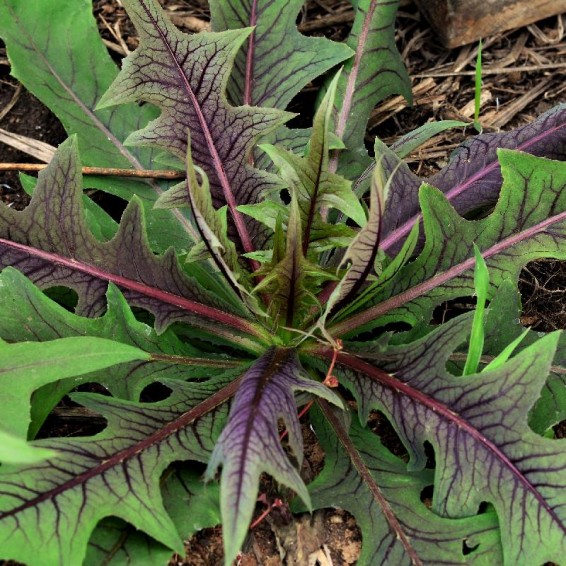Organic Catalogna Garnet Stem Endive Seeds
Cichorium intybus
- HOW TO GROW
- FAST FACTS
HOW TO GROW
Sowing: Endive makes an excellent fall crop, since light frost sweetens the taste, and excess heat causes bitterness in the leaves or bolting. For an early summer crop, sow seeds indoors 2 months before the last spring frost; sow them 1/4" deep. When the seedlings emerge, thin them to 6" apart. Four weeks after planting them, set them outside 12" apart. For a fall crop, direct sow seeds in July. Water the ground, scatter the seeds on the surface, then cover with 1/3" of soil. When the seedlings emerge, thin them to 12" in all directions. Areas with warmer winters may be able to plant a winter crop about two months before the last frost.
Growing: Keep the soil moist to prevent toughness or a bitter taste, but avoid getting the leaves wet as this may cause rotting. Mulch helps conserve moisture and control weeds. If desired, blanch the leaves about 2-3 weeks before harvesting by tying together the outer leaves to shade the inner part of the plant. Make sure that the leaves of the plant are completely dry before tying them, or rotting may result.
Harvesting: Cut individual leaves for baby greens as soon as they reach a good size for eating.
Seed Saving: Endive needs to be overwintered in order to produce seed. For areas with severe winters, this requires cutting the plant down to 2" and storing the roots in a humid location in damp sand at 33-40 degrees F until spring, when they can be replanted. Endive can survive milder winters with a thick layer of mulch. Allow the plant to flower and go to seed; when the seed heads are dry and the seeds feel dry and firm, spread them out on a surface to dry for at least 10 days. Either plant the seed heads whole or clean them by putting them in a bag and applying pressure with a heavy weight. Store the seeds in a cool, dry place for up to eight years.
FAST FACTS
Latin Name: Cichorium intybus
Type: Open Pollinated, Cool Season
USDA Zones: 3, 4, 5, 6, 7, 8, 9, 10, 11, 12
Seeds per Ounce: 25,000
Planting Method: From Transplant
Sunlight: Full Sun
Height: 8 Inches
Color: Green
DESCRIPTION
HOW TO GROW
Sowing: Endive makes an excellent fall crop, since light frost sweetens the taste, and excess heat causes bitterness in the leaves or bolting. For an early summer crop, sow seeds indoors 2 months before the last spring frost; sow them 1/4" deep. When the seedlings emerge, thin them to 6" apart. Four weeks after planting them, set them outside 12" apart. For a fall crop, direct sow seeds in July. Water the ground, scatter the seeds on the surface, then cover with 1/3" of soil. When the seedlings emerge, thin them to 12" in all directions. Areas with warmer winters may be able to plant a winter crop about two months before the last frost.
Growing: Keep the soil moist to prevent toughness or a bitter taste, but avoid getting the leaves wet as this may cause rotting. Mulch helps conserve moisture and control weeds. If desired, blanch the leaves about 2-3 weeks before harvesting by tying together the outer leaves to shade the inner part of the plant. Make sure that the leaves of the plant are completely dry before tying them, or rotting may result.
Harvesting: Cut individual leaves for baby greens as soon as they reach a good size for eating.
Seed Saving: Endive needs to be overwintered in order to produce seed. For areas with severe winters, this requires cutting the plant down to 2" and storing the roots in a humid location in damp sand at 33-40 degrees F until spring, when they can be replanted. Endive can survive milder winters with a thick layer of mulch. Allow the plant to flower and go to seed; when the seed heads are dry and the seeds feel dry and firm, spread them out on a surface to dry for at least 10 days. Either plant the seed heads whole or clean them by putting them in a bag and applying pressure with a heavy weight. Store the seeds in a cool, dry place for up to eight years.
FAST FACTS
Latin Name: Cichorium intybus
Type: Open Pollinated, Cool Season
USDA Zones: 3, 4, 5, 6, 7, 8, 9, 10, 11, 12
Seeds per Ounce: 25,000
Planting Method: From Transplant
Sunlight: Full Sun
Height: 8 Inches
Color: Green




